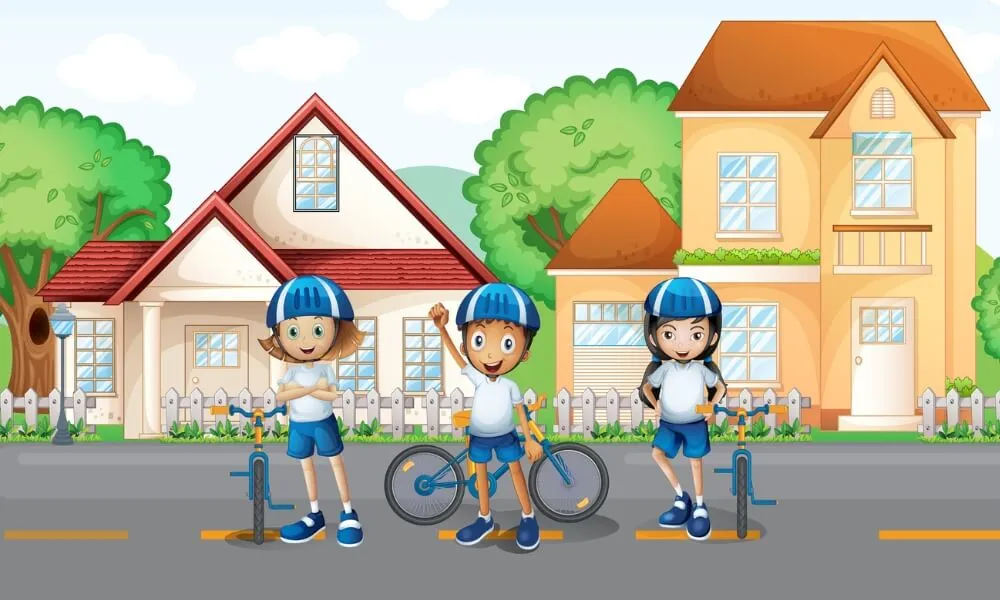As drivers, we share the responsibility of ensuring the safety of everyone on the road, especially the most vulnerable among us – children. Their unpredictable nature and small stature make them difficult to spot, and accidents involving children are often tragic. We must be proactive, vigilant, and well-informed to make our roads safer for these young pedestrians.
In this blog, we’ll explore practical tips and strategies to help you drive safely around children, reducing the risk of accidents and making our streets more secure for all. From understanding how to approach school zones and residential areas to identifying common risk factors, this guide will provide you with the knowledge and tools to navigate the road confidently and carefully. Join us as we embark on this important journey towards safer driving around our precious little ones.
How To Drive Safely Around Children
Whether or not you have children, you must learn how to drive when they’re around to avoid potential injuries and fatalities. Driving safely around children means keeping in mind their unpredictable nature, which translates to you slowing down and paying more attention to the road. Pay special attention to schools, residential neighborhoods, and other areas where kids congregate, but keep your eyes peeled whenever you see or anticipate children being around.
Driving around children can be a challenge, especially if you are not used to it. The following tips will help you drive safely around children and avoid potential hazards.
Using Caution Whenever Kids May Be Around
Be Vigilant During Times When Children Are Most Likely To Be Outside
Children are most likely to be outside during specific times, such as before and after school, as well as on weekends, holidays, and summer breaks. To ensure their safety, it’s crucial to be vigilant while driving during these periods.

Never assume that children are not present simply because it’s dark outside. Instead, always be prepared for the possibility of children being nearby and adjust your driving accordingly.
Consider these tips to enhance your alertness and keep children safe:
- Be aware of peak hours: Familiarize yourself with the local school schedules and popular outdoor playtimes. This will help you anticipate when children are most likely to be outside.
- Slow down in residential areas and school zones: Adhere to posted speed limits and reduce your speed when driving where children may be present.
- Use extra caution at intersections and crosswalks: Children may not always follow traffic rules or be aware of their surroundings. Be prepared to stop or yield to pedestrians, even if they aren’t at designated crossing areas.
- Stay focused and avoid distractions: Avoid activities that might divert your attention from the road, such as using your phone, eating, or adjusting the radio.
- Be mindful of parked cars and hidden driveways: Children may suddenly dart out between parked vehicles or driveways that are difficult to see.
- Use your headlights and turn signals: Ensure your vehicle’s lights function properly to increase visibility and communicate your intentions to other road users, including children.
- Keep an eye out for bicycles and scooters: Children riding bikes and scooters may not be as visible as pedestrians. Be prepared to share the road and maintain a safe distance from them.
By staying vigilant and following these guidelines, you can help ensure the safety of children in your community and reduce the risk of accidents.
Keep An Eye Out For Children Darting Around Residential Neighborhoods
Children frequently play outdoors in residential neighborhoods after school, on sunny days, and even during snowy weather. They may be riding bikes, running, or engaging in other activities, making it challenging to slow down quickly if you’re driving above the speed limit.
Speed limits in residential areas are typically set at 25 mph (40 kph) or lower. Adhere to these limits to ensure ample reaction time in case children suddenly appear in the road. Consider the following tips to improve safety:
- Observe posted speed limits: Pay close attention to speed limit signs in residential areas, and always stay within the designated limit to maintain a safe driving environment.
- Be prepared for the unexpected: Children can be unpredictable, so always anticipate sudden movements and be ready to react accordingly.
- Keep a safe distance from parked cars: Give yourself more time to react by maintaining a safe distance from parked vehicles, as children may dart out from behind them without warning.
- Scan the area: Continuously scan your surroundings, looking for signs of children playing, such as bicycles, toys, or sports equipment near the road.
- Drive cautiously in inclement weather: Adjust your driving speed to accommodate poor visibility and reduce reaction time during adverse weather conditions.
- Exercise extra caution near parks and playgrounds: Be particularly vigilant in areas where children are more likely to congregate, such as near parks, playgrounds, and schools.
By staying attentive and adhering to speed limits in residential areas, you can help ensure the safety of children and reduce the likelihood of accidents.

Turn The Corners Of Your Neighborhood Slowly
Children frequently play in front of their homes in residential areas, making it essential to turn corners slowly to avoid accidents. In particular, kids may dart into the street without noticing you turning. Here are some tips to improve safety:
- Reduce speed when turning: Slow down as you approach corners to give yourself ample time to react if children are present.
- Check your surroundings: Scan your surroundings before turning and watch children playing outside, especially if they’re engaged in ball games or other activities that may cause them to run into the road.
- Avoid distractions: Stay focused on the road, such as using your phone, eating, or adjusting the radio.
- Be mindful of ice cream trucks: Children may run towards them without attention to traffic, so exercise extra caution when driving near them.
- Communicate with other drivers: Use your turn signals and communicate with other drivers to avoid confusion and potential accidents.
By being cautious and attentive when turning corners in residential areas, you can help ensure the safety of children and prevent accidents.
Back Out Of Your Driveway Slowly
Children may be walking or playing behind your vehicle, making it crucial to back out of your driveway slowly and carefully. Follow these guidelines to ensure safety:
- Check your surroundings: Before getting into your vehicle, take a quick glance around your driveway to ensure that no children are present.
- Back up slowly: Reduce speed and back out of your driveway slowly to allow time to react in case a child suddenly appears.
- Use mirrors and cameras: Use your rearview mirror and backup camera, if available, to monitor your surroundings while backing out.
- Use caution while driving forward: Always exercise caution when driving forward out of your driveway, as children may be present on the sidewalk or near the curb.
- Use backup warning systems: If your car has a backup warning system, use it to alert you to any obstacles in your path.
- Be mindful of blind spots: Always be aware of your vehicle’s blind spots, as children may be present in these areas.
By being cautious and attentive when backing out of your driveway, you can help ensure the safety of children and prevent accidents. Remember to always check your surroundings, reduce speed, and use any available safety features to avoid potential hazards.

Drive Carefully Along Streets That Are Lined With Parked Cars
Streets lined with parked cars can present a challenge for drivers when it comes to spotting children who may be playing nearby or about to cross the street unexpectedly. To ensure the safety of children in these areas, follow these tips:
- Drive slowly: Reduce your speed and exercise caution when driving along streets with parked cars, especially if you see feet or other signs of children playing nearby.
- Be vigilant: Keep a watchful eye out for children who may be between parked vehicles or approaching the street from the side.
- Look for warning signs: Watch for toys or bicycles that may be left near the road, as these could be an indication that children are present in the area.
- Don’t assume anything: Just because a crosswalk is nearby does not guarantee that children will use it. Always be prepared for children to cross the street unexpectedly.
- Stay alert at all times: Avoid distractions while driving and stay focused on the road to increase your reaction time and reduce the risk of accidents.
By driving carefully and staying vigilant when traveling along streets with parked cars, you can help ensure the safety of children and prevent potential accidents. Remember to reduce speed, keep an eye out for warning signs, and stay alert at all times.
Be Careful When Driving On Streets With No Sidewalks
Streets without sidewalks can pose a particular risk to children who may be walking or playing nearby. To ensure their safety, follow these guidelines when driving on streets without sidewalks:
- Reduce speed: Slow down and drive cautiously when traveling on streets without sidewalks, especially if children are present.
- Give children a wide berth: Provide ample space when passing children who may be walking or playing near the edge of the road.
- Stay alert: Be mindful of your surroundings and watch for children who may dart into the street unexpectedly.
- Use your horn sparingly: Refrain from honking your horn, as this can startle children and potentially cause them to run into the street.
- Yield to pedestrians: Give pedestrians the right of way when they are crossing the street, even if it’s not at a designated crosswalk.
By exercising caution and following these tips, you can help ensure the safety of children when driving on streets without sidewalks. Remember to reduce speed, provide ample space when passing, stay alert, and yield to pedestrians.
Keep Your Eyes On The Road When You Drive Around Children
Focusing on the road is crucial when children are present to prevent potential accidents. Follow these guidelines to ensure their safety:
- Avoid distractions: Eliminate distractions that may divert your attention from the road, such as using your phone, eating, or adjusting the radio.
- Stay alert: Keep a watchful eye out for children playing or walking nearby, especially in areas where they are more likely to be present, such as parks, schools, and residential areas.
- Reduce speed: Slow down and exercise caution when driving in areas where children are present, as they may run into the street unexpectedly.
- Follow traffic rules: Always adhere to posted speed limits, traffic signals, and signs, and yield to pedestrians as required by law.
- Focus on driving: Remember that driving safely is your primary task, and everything else can wait until you reach your destination.
By staying focused on the road and eliminating distractions when driving around children, you can help ensure their safety and prevent potential accidents. Remember to stay alert, reduce speed, and follow traffic rules to maintain a safe driving environment.

Being Extra Careful Near Schools
Obey The Speed Limit In School Zones
School zones typically have reduced speed limits during school hours, often designated by flashing lights and signs. Even if you don’t see children present, obeying these speed limits is important to ensure their safety. Here are some tips to follow:
- Pay attention to speed limit signs: Be aware of school zone speed limits and watch for flashing lights and signs that indicate when the reduced speed limit is in effect.
- Reduce speed accordingly: Slow down and adhere to the posted speed limits in school zones to allow time to react if a child suddenly appears.
- Stay alert: Keep a watchful eye out for children who may be walking or playing near the road, and be prepared to stop or yield to pedestrians.
- Avoid distractions: Eliminate distractions that may divert your attention from the road, such as using your phone or eating.
- Follow traffic rules: Adhere to traffic signals and signs, and yield to pedestrians as the law requires.
- Be aware of the consequences: Remember that speeding tickets in school zones can result in hefty fines and possible license suspension and pose a significant risk to children’s safety.
By following these tips and adhering to speed limits in school zones, you can help ensure the safety of children and avoid costly consequences. Remember to stay alert, reduce speed, and eliminate distractions to maintain a safe driving environment.
Don’t Lose Focus Just Because You’re Beyond The School Zone
Even after leaving a school zone, staying alert and focused on the road is essential. Children may be present in nearby areas, such as playgrounds, parks, or residential neighborhoods, and may be less mindful of their surroundings. Here are some tips to follow:
- Pay attention to surrounding areas: Be aware of nearby areas where children often hang out, especially before and after school, such as playgrounds and parks.
- Reduce speed: Slow down and exercise caution when driving in areas where children are present, as they may be more active and less mindful of their surroundings.
- Stay alert: Keep a watchful eye out for children who may be walking or playing near the road, and be prepared to stop or yield to pedestrians.
- Avoid distractions: Eliminate any distractions that may divert your attention from the road, such as using your phone or eating.
- Follow traffic rules: Adhere to traffic signals and signs, and yield to pedestrians as required by law.
By following these tips and maintaining focus beyond school zones, you can help ensure the safety of children and prevent potential accidents. Remember to stay alert, reduce speed, and eliminate distractions to maintain a safe driving environment.

Never Pass A School Bus That Has Stopped And Put Out Its Stop Sign
When a school bus has stopped and put out its stop sign, it’s crucial to obey traffic laws and not pass the bus. Children will be entering or exiting the bus, and may dart in front of your car unexpectedly. Here are some tips to follow:
- Watch for school buses: Be aware of school buses on the road, and keep a watchful eye out for flashing lights, extended stop signs, or both.
- Do not pass the bus: By law, you cannot pass a stopped school bus, whether behind or facing it. Wait patiently for the bus to pull away.
- Exercise caution after the bus leaves: Be extra cautious when driving near children after the bus leaves, as they may be walking or playing near the road.
- Stay alert: Always be alert when driving near schools or school buses, and be prepared to stop or yield to pedestrians.
- Follow traffic rules: Adhere to traffic signals and signs, and yield to pedestrians as required by law.
By following these tips and obeying traffic laws when driving near school buses, you can help ensure the safety of children and prevent potential accidents. Remember to stay alert, exercise caution, and adhere to traffic rules to maintain a safe driving environment.
Obey The Crossing Guard
Crossing guards are important in keeping children safe when crossing busy intersections near schools. It’s crucial to show respect for their safety and follow their commands to ensure the safety of children. Here are some tips to follow:
- Watch for crossing guards: Be aware of crossing guards near schools and follow their instructions carefully.
- Give children ample time to cross: Whether there is a crossing guard present or not, be patient and allow younger children plenty of time to cross at pedestrian crossings.
- Exercise caution near schools: Slow down and exercise caution when driving near schools, as children may be walking or playing near the road.
- Stay alert: Keep a watchful eye out for children who may be crossing the street or walking near the road.
- Follow traffic rules: Adhere to traffic signals and signs, and yield to pedestrians as required by law.
By following these tips and exercising caution when driving near schools and crossing guards, you can help ensure the safety of children and prevent potential accidents. Remember to stay alert and patient and follow traffic rules to maintain a safe driving environment.
Conclusion
Driving safely around children is a critical responsibility for all drivers. Children are vulnerable and unpredictable, and it is up to drivers to exercise caution and follow traffic rules to keep them safe. Drivers must always be aware of their surroundings and keep their speed in check, especially in areas where children are likely to be present, such as schools, parks, and residential areas.
Additionally, drivers should minimize distractions and avoid texting or using the phone while driving, as these activities can significantly impair their ability to react to sudden changes in the road. By taking these steps and being mindful of the presence of children on the road, drivers can help ensure that every child can grow up safely and healthily.

